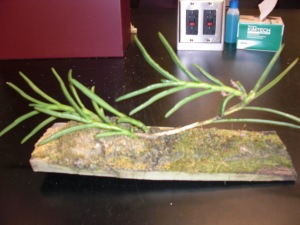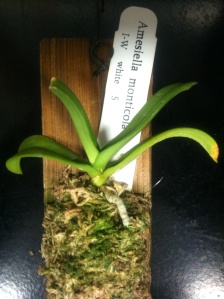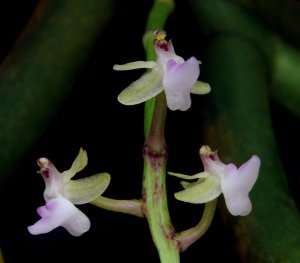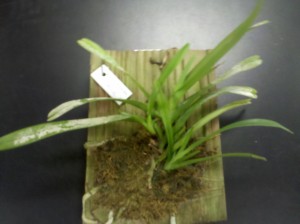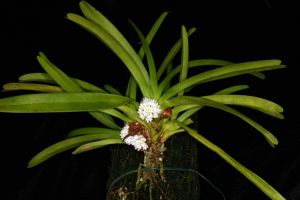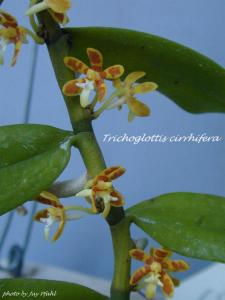Archive for category The Species
Cleisocentron merrillianum
Posted by malloryshayscott in The Species on March 4, 2011
Dimorphorchis lowii
Posted by hihowareyou13 in The Species on March 3, 2011
The orchid species Dimorphorchis lowii (Low), researched by Jamie and Whitney, is native to Borneo in forests at elevations from 0 to 1300 meters. The species is a member of the subtribe Aeridinae. . Dimorphorchis lowii is monopodial, meaning it grows upward from a single point. It is large sized, likes hot to warm environments and is epiphytic (grows non-parasitically on another plant or object). The plant has long pendant, stout, stems carrying ligulate (strap shaped), unequally bilobed at the apex leaves that are articulated to the sheathing leaf base. This species has two distinctly different flowers, both of which are fragrant. The basal flowers are yellow with purple spots, with hairs on the outer surface, 2″ tall and 2 2/5″ across, and have the sepals and petals overlapping. The apical flowers have yellow with large, maroon blotches, 2 2/5″ tall and 2 1/2″ across, with the sepals and petals separated and having undulate (wave like) margins as well as being hairy on the outer surface.
The picture to the left is our research plant (obviously very young). The picture to the right shows the two different flower types of Dimorphorchis lowii.
References:
http://www.orchidspecies.com/diphmlowii.htm
https://lab.troymeyers.com/flasking/item.php?kind=flask&id=TN6975
Angraecum calceolus
Posted by lianne6 in The Species on March 3, 2011
 The orchid species Angraecum calceolus (Thouars) is a member of the subtribe Angraecinae. It is native to Madagascar, but also found in the Comoro Islands, Mascarene Island, and Seychelles. It is a miniature plant that usually doesn’t get much larger than 25-30 cm across. It is an epiphyte, grows on other plants, and a lithophytic, grows in or on rocks. This plant is known for the fact that it can practically grow itself. Its blooms are typically green and may shade to white. This species primarily flowers from December to January in warm to hot environments
The orchid species Angraecum calceolus (Thouars) is a member of the subtribe Angraecinae. It is native to Madagascar, but also found in the Comoro Islands, Mascarene Island, and Seychelles. It is a miniature plant that usually doesn’t get much larger than 25-30 cm across. It is an epiphyte, grows on other plants, and a lithophytic, grows in or on rocks. This plant is known for the fact that it can practically grow itself. Its blooms are typically green and may shade to white. This species primarily flowers from December to January in warm to hot environments of forested coastal shores. The flowers are yellowish-green and usually grow to 2 cm. The picture above is a picture of the plant and the picture to the right is the specimen that we are working with. These flowers are very fragrant at night. Because of their long nectary the members of the Angraecum are pollinated by moths.
of forested coastal shores. The flowers are yellowish-green and usually grow to 2 cm. The picture above is a picture of the plant and the picture to the right is the specimen that we are working with. These flowers are very fragrant at night. Because of their long nectary the members of the Angraecum are pollinated by moths.
References:
Lianne Stricklen & Joe Stroup
Amesiella monticola
Posted by ashokbaniya in The Species on March 3, 2011
http://weisang.blogspot.com/2007_08_01_archive.html
Lab picture
TAXONOMY:
- Domain: Eukaryota
- Kingdom: Plantae
- Phylum: Tracheophyta
- Class: Liliopsida
- Order: Orchidales
- Family: Orchidaceae
- Tribe: Vandeae
- Subtribe: Aeridinae
- Scientific Name: Amesiella monticola
- Species Authority: J. E. Cootes and D. P. Banks
Research by- Mr. Baniya and Mr. Weed
Amesiella monticola is found growing in the rainforest at elevations of 1800 to 2200 meters. The species is native of Luzon, Philippines. It is a small, compact species with very large white flowers in proportion to the leaves. This species is monopoidal, upright orchid which is 2.5 cm tall and 16 cm wide. The pure white, fragrant flowers are about 6 cm in diameter, sometimes with a small blotch of yellow in the center of the lip. There are 2 to 6 flowers per spike with several spikes when mature. Roots are 4.5 mm in diameter and do not branch. The leaves are thick, leathery, linear to obovate, unequally bi-lobed apically and are up to 9.5 cm long and 2.5 cm wide. The flowers bloom from fall to spring. This plant prefers intermediate to warm temperatures. It can grow in winter minimum of 2 degree celsius to extremes of about 40 degree celsius with adequate shading and air circulation. Some threat includes habitat loss and over-collection for trade. It is utilized as an ornamental plant. Etymology: Latin word ‘monticola’ meaning ‘dwelling in mountainous regions’ refers to the habitat of the species.
| Citation: | Agoo, E.M.G., Cootes, J., Golamco, A., Jr., de Vogel, E.F. & Tiu, D. 2004. Amesiella monticola. In: IUCN 2010. IUCN Red List of Threatened Species. Version 2010.4. www.iucnredlist.org>. Downloaded on 03 March 2011 |
Luisia teretifolia
Posted by ycofer in The Species on March 1, 2011
Yasmin Cofer and Betsy Rogers are studying the orchid species Luisia teretifolia (C. Gaudichaud). This orchid is in the tribe Vandeae, and is a member of the subtribe Aeridinae. It is primarily native to New Guinea, although it is found in various parts of southeast Asia–from the Malay peninsula to Vanatu, throughout the Marina Islands, New Caledonia, the Himalayas, India, Thailand, and all the way to Australia. Pictured below is the plant sampled from lab:
This orchid grows either erect, climbing, or semi-pendulous upon trees, especially in the rainforest, and prefers warm temperatures and moderate sunlight. It can grow at altitudes from sea level up to 1,500 m above sea level, and when the orchid is mature it can grow up to 70 cm in height. Its leaves are terete–meaning they are fairly cylindrical and taper at both ends–and ridged, fleshy, and distichous, growing long and erect. The flowers bloom in the winter, and the colors of the labellum vary from yellow, to yellow green, to wine red, to maroon. The flowers are typically 1 – 1.5 cm across with narrow, oblong, strap-shaped petals, and tend to grow in clusters of 3 – 10; they are known for being waxy and having a slightly foul smell. Pictured below is an example of the plant when flowering:
The orchid is considered fairly common and wide-spread, and is not endangered.
References:
http://www.orchidspng.com/field_notes05.html
http://www.orchidspecies.com/luisiateretifolia.htm
Cleisostoma arietinum
Posted by suzannesymk in The Species on March 1, 2011
Suzanne Maggioni and Crystal Shuptrine are researching the orchid species Cleisostoma arietinum. This species is epiphytic and grows best when exposed to bright or full light and at an altitude of between 500 and 600 meters. It grows in a range of hot to cool temperatures, but its preferred habitat is localized to tropical environments. As such, it is no surprise that it is primarily found in southeast Asia (northeast India, Burma, Thailand, Laos, Malaysia, and Vietnam). C. arietinum is a short-stemmed plant that grows only to about six inches tall. The leaves are arranged in two vertical rows on opposite sides of the stem (distichous) and are cylindrical and fleshy, with a slight tapering at the ends (terete). It produces inflorescences that branch off and can reach around four inches in length that contain many small flowers. The flowers themselves are about ¼ inch in size and bloom in the Spring.
Taxonomy:
Order: Orchidales
Family: Orchidaceae
Subfamily: Epidendroideae
Tribe: Vandeae
Subtribe: Aeridinae
References:
http://www.orchidspecies.com/cleisosarientinum.htm
http://orchids.la.coocan.jp/Cleisostoma/Cleisostoma%20arietinum/Cleisostoma%20arietinum.htm
Photo References:
http://picasaweb.google.com/lh/photo/yTEVwNaXVX5jtXWYUkCC2w
Ancistrorhynchus metteniae
Posted by gwendolynclarke in The Species on March 1, 2011
Erin Billingsly, and Gwen Clarke are researching Ancistrorhynchus metteniae (Kraenzl.), a member of the Aerangidinae subtribe. It is generally found in Nigeria, Sierra Leone, Central African Republic, Cameroon, Equatorial Guinea, Gabon, Zaire Ethiopia, Uganda, and Tanzania. It grows most successfully at elevations 0f 900 to 1300 meters in shady, warm (between 68-75 deg. F), and humid environments. It is typically a small to medium sized epiphyte growing up right on other vegetation, typically trees. Their small flowers rarely open fully, and do not last long. The flowers are only about a cm in length, and blooms in October on the lower leaves. It has multiple blossoms, and the leaves are thin, flat, and narrow. The leave generally grow 5-25 cm in length. As the plant grows the leaves appear to be stacked, growing vertically. They have a bright green coloration, and the flowers are white.
Our sample is still growing, but due to the size of the habitat, not sure how much more it will grow. Here is a picture of a larger blooming orchid below with a closer view of the flower underneath.
The Ancistrorhynchus metteniae was named after a German orchid enthusiast (Metteniae in the late 1800’s
http://www.orchidspecies.com/ancimetteniae.htm
Angraecoid Orchids. Stewart, J., Hermans, J., Campbell, B., Timber Press, Copy write 2006.
Angraecopsis parviflora (Thouars)
Posted by lc6939 in The Species on March 1, 2011
Jamie Cone and Lennin Castellon are working with Angraecopsis parviflora (Thouars).
Order: Asparagales
Family: Orchidaceae
Tribe: Vandeae
Subtribe: Aerangidinae
Genus: Angraecopsis
Description: Small sized, hot to warm growing epiphyte with a spreading to pendant, short stem. (picture to the right – shows our actual lab plant)
Habitat: Found in mixed evergreen and riverine forest, often growing fairly low on tree trunks
Distribution: Ivory Coast, Cameroon, Tanzania, Malawi, Mozambique, Zimbabwe, Mauritius, Reunion and Madagascar in lower montane forests.
Altitude: found at elevations of 600 to 1600 meters.
Leaves: 5-10, linear to rounded apex with tapering base. Curved and tapering point. Basally twisted, all in one plane, unequally lobed at apex
Flowers: Blooms in the late spring through fall (Jan – Mar). 2-8 flowers, held in apical third. 2 to 4″ [5 to 10 cm] long. Inflorescence spirally arranged on a long slender peduncle (stem). (Picture below shows a flowering plant growing in the wild)
References
http://www.orchidspecies.com/angparviflora.htm
http://www.zimbabweflora.co.zw/speciesdata/species.php?species_id=118720
Trichoglottis cirrhifera
Posted by accordry in The Species on March 1, 2011
Charriz Weed and Amber Cordry are doing research on the orchid Trichoglottis cirrhifera Teijsm. & Binn. 1853.
These orchids are a part of the Vandae tribe, sub-tribe Aeridinae.
Trichoglottis cirrhifera is found growing in the countries of Vietnam, Laos, Thailand, Malaysia and Java. Generally found around elevations of 50 to 400 meters, this monocot grows in areas of bright or full light in moderate temperatures. Trichoglottis cirrhifera blooms from winter to spring with many 1.15 cm wide flowers. These epiphytes have a long, slender stem that carries small, imbricating ovate leaves and blooms on a short, axillary, single-flowered influorescence by holding the flower close to the stem. Flowers occur every 1 to 2 influorescence at each and every leaf junction.
The particular orchid that we are working with has flowers that are gold with chocolate spots.
http://orchids.wikia.com/wiki/Trichoglottis_cirrhifera
http://www.orchidspecies.com/trichocirrhifera.htm

Image of Orchid in Nature
http://www.orchidfoto.com/displayimage.php?album=126&pos=2

Side view
http://www.orchidspecies.com/orphotdir/trichogcirrhifera.jpg

Lip and Column View
http://www.orchidspecies.com/orphotdir/trichoglotticirrhifer.jpg

(Edited March 9, 2011 by Amber Cordry to include the following information: authority of species, more details on the plant characteristics, such as leaf, stem, and flower information, as well as additional photos to highlight plant characteristics)
Trichoglottis triflora
Posted by lizbates11 in The Species on March 1, 2011
Mike Byers and Liz Bates have the pleasure of working with Trichoglottis triflora [Guillaumin], Garay and Seiderfadden (1972). This species is native to southwestern Vietnam and Thailand. It is an epiphytic growing, monopodial miniature orchid. Numerous short, densely grouped flowers are kept close to the plant, and typically exhibit 2-5 inflorescence at 0.25-0.5 cm. T. triflora typically blooms in the winter and spring, and favors temperatures from 48 degrees (minimum) to 98 degrees degrees Fahrenheit. Leaves are typically seperated by 1 and 1/2”. The plant has greenish yellow to brown sepals; the blossoms have a white to cream lip, with splashes of pink or purple dots and brightly colored anther caps. It belongs to the subtribe Aeridinae. Our plant can be seen below left.
A detailed image of the flower can be seen at below right. 
Sources Cited:
“Andy’s Orchids,” accessed 2/27/11. http://andysorchids.com/searchresultsP.asp?Species=Any&Genus=Any&Country=Any&Light=Any&Bloom=Any&Temperature=Any&Mount=Any&Water_Care=Any&Color=Any&Price_Range=Any&Size=Any&Fragrant=0&Miniature=0&Easy_Grower=0
“Trichoglottis Triflora” accessed 2/27/11. http://www.orchidspecies.com/trictrif.htm

